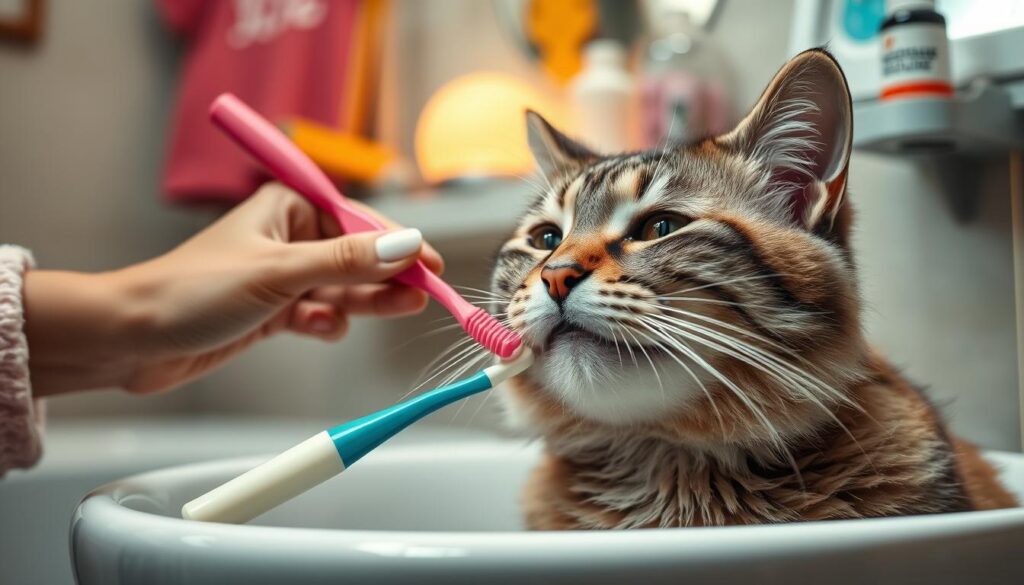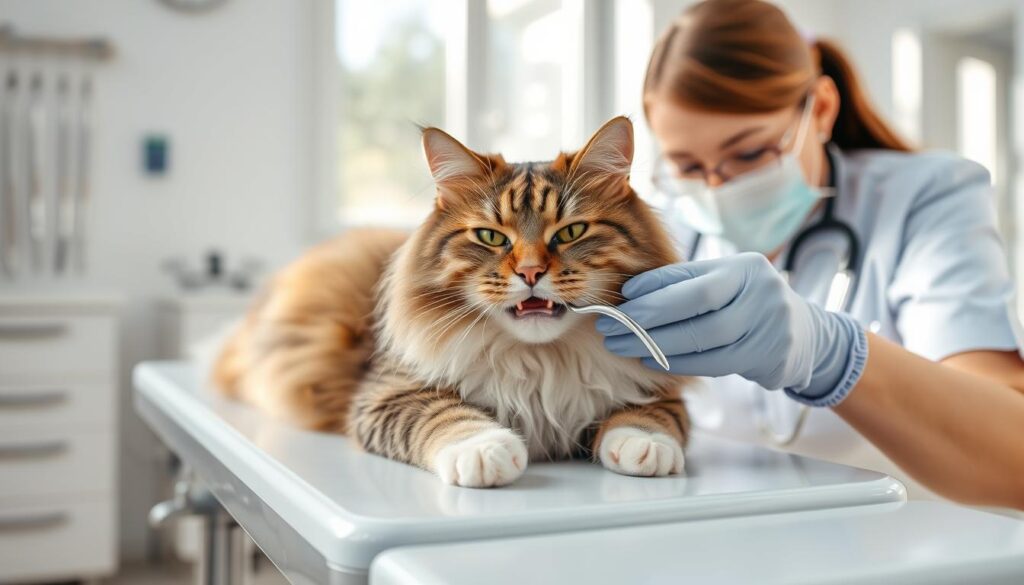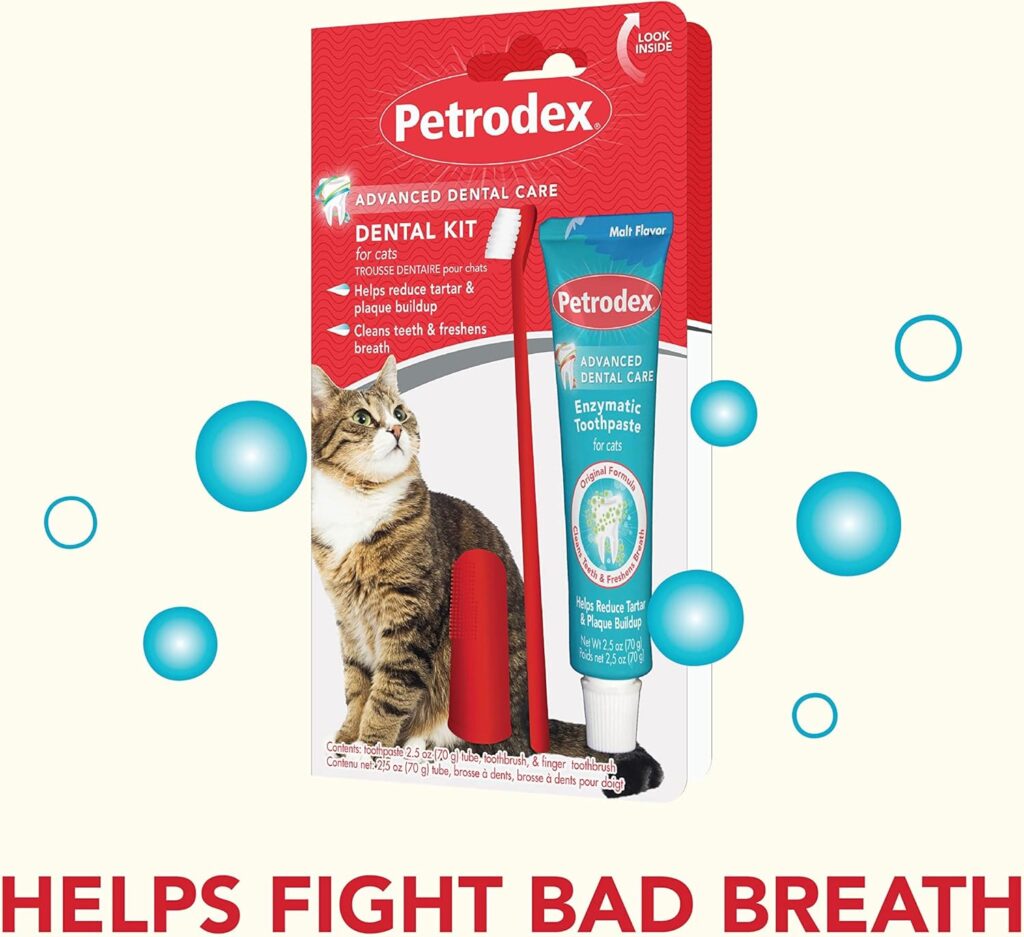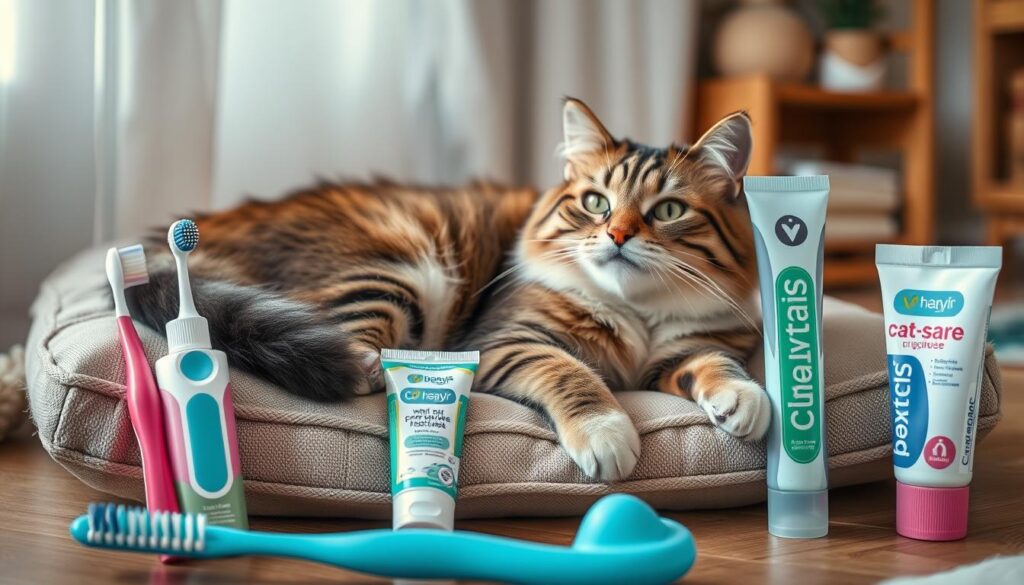As a devoted cat parent, you cherish your feline companion’s every purr and playful moment. But have you ever stopped to consider the importance of caring for your cat’s teeth? Often overlooked, your cat’s oral health is a critical aspect of their overall well-being. Dental disease is alarmingly common in cats, affecting a staggering 75% of those over the age of 5.
Left unchecked, it can lead to excruciating pain, tooth loss, and even systemic health issues. In this comprehensive guide, we’ll explore the essential tips and strategies to keep your cat’s smile healthy and bright.
The Importance of Maintaining Your Cat’s Dental Health
Caring for your cat’s cat dental health is key for their happiness. Bad feline dental care can cause pain and make eating hard. It can also spread bacteria to vital organs, leading to serious cat dental systemic health issues.
Preventing Pain and Discomfort
Good cat oral hygiene stops dental pain and keeps your cat comfy. Regular dental checks and cleanings catch problems early. This protects your cat from cat dental pain.
Reducing the Risk of Systemic Health Issues
Good cat dental disease prevention keeps teeth and gums healthy. It also lowers the risk of body-wide health problems. Untreated dental issues can spread bacteria, harming the heart, kidneys, and more.
“By prioritizing your cat’s dental care, you can prevent pain and discomfort, as well as reduce the likelihood of systemic health problems down the line.”
Identifiers of Healthy Cat Teeth
Keeping your cat’s teeth healthy is key to their happiness. Knowing the signs of healthy teeth helps you spot problems early. Look for clean, white teeth, pink gums, and no bad breath or tartar.
Clean, White Teeth
Healthy cat teeth are mostly white. Some cats may have darker teeth due to their breed or age. But, they should still look clean and even.
Brushing regularly and a good diet can prevent plaque and tartar. This stops teeth from staining and looking discolored.
Pink, Healthy Gums
A cat’s gums should be a bright pink. If they’re red, swollen, or inflamed, it could mean dental trouble. Watching your cat’s gums helps catch problems before they get worse.
Absence of Bad Breath and Tartar Buildup
A healthy cat doesn’t have bad breath or too much tartar. Bad breath can mean dental disease. Too much tartar can cause tooth loss and infections.
Regular dental cleanings and good dental care prevent these issues. This keeps your cat’s breath fresh and their teeth healthy.
Knowing what healthy cat teeth look like helps you care for your cat’s mouth. Regular vet visits and a dental care routine are crucial for your cat’s dental health.
Common Dental Problems in Cats
Cats can face many dental issues if their teeth aren’t cared for. These include feline periodontal disease, cat gingivitis, cat tooth resorption, cat stomatitis, cat tooth fractures, cat oral tumors, and cat halitosis.
Periodontal disease is a big problem. It’s when the gums and tissues around the teeth get inflamed and infected. Over half of cats over three have dental disease, making it a common issue for vets.
Without treatment, dental problems can cause pain, tooth loss, and health issues. It’s crucial to take care of a cat’s teeth to avoid these problems.
Stomatitis is another common issue. It’s a severe inflammation of the mouth and gums. Up to 60% of cats with stomatitis see their symptoms improve, while 40% still face some inflammation.
Stomatitis cases need a vet dentist for specific treatment. This ensures the cat gets the right care for their condition.
Juvenile gingivitis can appear in kittens from 6 to 12 months old. It requires regular dental checks and good home care. Some cats may need dental cleanings every 6–12 months, depending on their tartar buildup.
Vets help decide how often these cleanings are needed. This is based on how fast each cat’s teeth accumulate tartar.
Tooth resorption is a common reason for tooth loss in older cats. Over 70% of cats over five show signs of this. The Veterinary Oral Health Council checks dental products to see if they help prevent plaque and tartar.
Plaque is the main cause of dental disease in cats. Cats with periodontal disease show signs like gum recession and loose teeth. Tooth resorption is diagnosed by looking for tooth defects or using X-rays.
How to Brush Your Cat’s Teeth Effectively
Keeping your cat’s teeth clean is very important. Brushing their teeth regularly is a great way to do this. To make brushing easy and stress-free, pick the right tools and introduce them slowly to your cat.
Choosing the Right Tools
For effective cat tooth brushing, use a soft-bristled toothbrush and cat-safe toothpaste. Make sure the toothpaste tastes good to your cat. Don’t use human toothpaste, as it can be dangerous if they swallow it. Look for cat dental care tools made just for cats.
Gradually Introducing the Process
Getting your cat used to cat dental care routine takes time. Be patient and let your cat set the pace. Start by letting them sniff and explore the toothbrush. Give them treats and praise to make them associate it with good things. Slowly get them used to touching their teeth and gums, building trust before brushing.
Proper Brushing Technique
When brushing, use a gentle circular motion, focusing on the gum line. This is where cat dental hygiene is most important. Brush for about 30 seconds on each side of their mouth. Always end with praise and a treat. Brushing daily or every other day is best.
Brushing your cat’s teeth may take time and patience. But it’s one of the best ways to keep their teeth and gums healthy. By choosing the right tools, introducing them slowly, and brushing correctly, you can help your cat have healthy teeth and gums for life.

Cat dental care: Incorporating Dental Treats and Diets
Keeping your cat’s teeth clean is more than just brushing. Using cat dental treats, cat dental chews, and cat dental diets helps too. These items are made to clean teeth, preventing plaque and tartar buildup. This can stop gum disease and tooth loss.
Cat dental treats and chews make dental care easy. They encourage chewing, which removes plaque and tartar. Feline oral health supplements like water additives or dental wipes also help. They fight bacteria and prevent tooth decay.
Cat dental diets are a nutritional way to keep teeth clean. They have bigger kibble that makes your cat chew more. This improves dental health. The special kibble shape and texture clean teeth as your cat eats.
Using different dental care products is a good way to keep your cat’s teeth and gums healthy. Always talk to your vet before adding new products. Make sure they are safe and right for your cat.
“Consistency is key when it comes to your cat’s dental care. Aim to brush their teeth at least two to three times a week for optimal results.”
Professional Dental Cleanings for Cats
Regular at-home dental care is key for your cat. But, cat professional dental cleanings by your vet are also vital. These feline dental exams might be needed every 1-2 years. Your vet will check your cat’s teeth and gums, remove plaque and tartar, and fix any problems.
This often needs cat anesthesia for dental cleanings. It keeps your cat calm and ensures a deep clean.
Frequency and Importance
About 50-90% of cats over 4 have dental disease. Also, 42% of cats with normal-looking teeth have dental disease below the gum line. Regular cleanings prevent pain, discomfort, and serious health problems.
What to Expect During a Cleaning
Your vet will use special tools to clean your cat’s teeth during a cat dental procedures. They might take dental X-rays to find hidden issues. The cleaning requires cat anesthesia for dental cleanings to keep your cat safe and comfortable.
After, your vet will tell you how to care for your cat’s teeth at home and any needed follow-up treatments.
The cost of a cat professional dental cleanings at a vet clinic is $300 to $750. If extractions are needed, it can cost over $1,000. But, regular care can save money in the long run. Some pet insurance covers cleanings, and many clinics offer discounts in Pet Dental Health Month in February.

“Regular toothbrushing at home is recommended to reduce the need for professional dental cleanings, while alternatives like dental treats and chews may also help maintain dental health.”
Establishing a Consistent Dental Routine
Keeping your cat’s teeth clean is vital for their health. A regular dental care routine is essential. It should include daily tooth brushing, dental treats, and vet visits.
Experts say to brush your cat’s teeth every day, or at least 2-3 times a week. This helps prevent plaque, tartar, and gum disease. Start slowly so your cat gets used to it.
Dental treats and chews also help keep your cat’s mouth clean. They remove plaque and tartar, keeping teeth and gums healthy.
Regular vet visits and cleanings are also key. Dental diseases are common in cats over four, so yearly vet checks are important.
By making dental care a regular part of your cat’s life, you can avoid future dental problems. It might take time for your cat to adjust, but it’s worth it for their health and happiness.
| Dental Care Recommendation | Frequency |
|---|---|
| Brush your cat’s teeth | Daily or at least 2-3 times per week |
| Provide dental treats and chews | Regularly, as part of a balanced diet |
| Schedule veterinary check-ups and cleanings | At least once a year |
“Consistent dental care is essential for maintaining your cat’s overall health and well-being. By making it a routine, you can prevent painful and costly dental problems down the line.”
Conclusion
Keeping your cat’s teeth clean is key to their health. About 50% to 90% of cats over 4 have dental issues. Regular brushing, dental treats, and vet visits can prevent pain and health problems.
Vets say cats need their teeth cleaned yearly, but it can vary. Dental cleanings cost around $408.95 in Atlanta, GA. Older cats or those with health issues might need extra tests or procedures.
Sticking to a dental care routine is important for your cat’s smile. Dental disease is common and can harm their overall health if not treated. Taking care of your cat’s teeth is essential for their happiness and health.
FAQ
What are the signs of healthy cat teeth?
Healthy cat teeth are mostly white, without too much yellow. The gums should be a steady pink, not red or swollen. Also, a healthy cat won’t have bad breath or visible tartar.
What are some common dental problems in cats?
Cats often face issues like periodontal disease, gingivitis, and tooth resorption. They can also get stomatitis, tooth fractures, oral tumors, and bad breath. Periodontal disease is a big problem, causing inflammation and infection around the tooth.
How can I effectively brush my cat’s teeth?
First, pick a soft-bristled toothbrush and toothpaste your cat likes. Start slow, letting your cat get used to it. Brush gently, focusing on the gum line where plaque builds up.
Brush for 30 seconds on each side. Always end with praise and a treat.
How often should I take my cat for professional dental cleanings?
Cats might need dental cleanings every 1-2 years, depending on their health. At these cleanings, your vet will check teeth and gums, remove plaque and tartar, and fix any problems. This usually needs anesthesia to keep your cat safe and comfortable.
Why is maintaining my cat’s dental health important?
Keeping your cat’s teeth healthy is key for their overall health. Bad dental health can cause pain and make eating hard. It can also spread bacteria to vital organs, leading to serious health issues.
By focusing on dental care, you can avoid pain and prevent serious health problems later.


